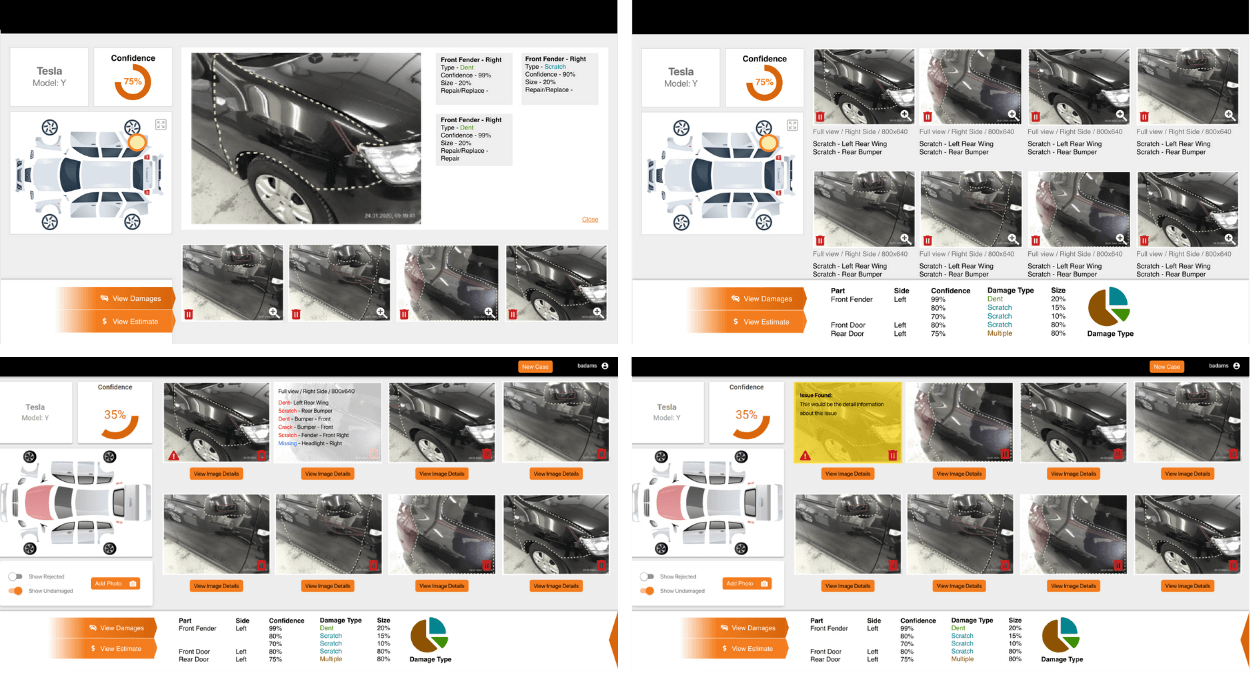A team of Keyhole Software consultants helped a multi-national company to develop an application focused on full automation of the insurance claims workflow process after a car accident. The development relied heavily on React and Java, and other key technologies include Artificial Intelligence, Spring Boot, Microservices, and REST.
Client and Application Overview
The client develops software solutions for the insurance industry. With over 235,000 partners in 90 different countries, it is a global leader in its field.
From a high level, the application analyzes photos of damaged vehicles and automates the return of an insurance estimate for the damage. The development heavily utilized React, with a Java back end.
The application would automate most of the effort of identifying and assessing vehicle damage following an accident. The application allows for uploading vehicle images after an accident.
Based on the uploaded images, the AI identifies the year, make, and model of the vehicle,
It has the capability to detect damaged parts, determine the type and severity of damage, define appropriate vehicle manufacturer repair operations, and create an estimate based on these pre-defined repair operations.
The application displays that information in a highly visual format, showing the base car model, a car diagram for “click-to-part” navigation, and each of the photos uploaded with contour drawings of the damaged parts. Clicking through the photos shows the damage identified in each one highlighted by a contour drawing around the damage and a cost estimate of the associated repair.
It also provides relative confidence of each of the estimates. In instances where the AI confidence level is lower, the software automatically flags the job for a manual check. This flag is available instantly to ensure unnecessary delays to the workflow are avoided.

Specific Technologies
- React for front-end development
- Back-end Java with REST APIs
- Sophisticated AI written in Python (client’s data science team)
- Adobe.XD for UI/UX design and application flow
- Google Cloud Platform for Microservices, PubSub – decoupled services through queue, and Memorystore
Main Development Tasks
Front-End Development
The front end of the application was developed using React. In addition to building out the front end with React, the team worked to design the UI as well.
The application returned the image coordinates of the vehicles, which allowed the team to create a UI that contained an interactive car diagram allowing the user to view the damage contours on the images. Other data displayed by the UI includes confidence levels of the detected damages pulled from the API and a data summary with breakdowns by damage type and location and charts to quickly ascertain the overall damages.
A key Keyhole Consultant was also tasked with reviewing and improving the UX and designing the user interface to make it easy for estimators to create estimates and review with clients.
Back-End Development
The team’s back-end development included designing and implementing image handling and contour drawing generation with Java.
Keyhole consultants also worked to create user authentication for the application, and OAuth with Google and Facebook was utilized to accomplish this. Numerous interfaces for proprietary information were also created.
Methodology
The front-end development was completed using a Kanban Agile methodology, tracking user stories on a simple Trello board. The full team (product owner, UI/UX designer, front-end developer, and back-end developer) met twice each week to review work completed, prioritize the backlog, and add new user stories to the backlog.
Milestone product demonstrations were set and scheduled by the product owners. The team prioritzed and made decisions on what tasks to accomplish or modify according to these target dates. A quick sizing exercise was done to establish relative sizing of the base user stories in order to estimate delivery capacity between milestone dates.
The team was 100% remote, utilizing Zoom calls for status meetings and demos. A high-level status report was generated weekly to keep the product owners informed of the overall velocity and productivity of the team.
Project End Status
The application was successfully developed and deployed. The application significantly increased the efficiency of the client’s ability to process claims.
With the new Java and React-based development, up to 50% of claims received are now able to be automatically approved through the application’s AI system. The system’s results can be shared in real-time with a body shop, assessor, and insurer. This has significantly impacted the operating costs of those who use the application; operating costs have also been estimated to be reduced by 50%.










